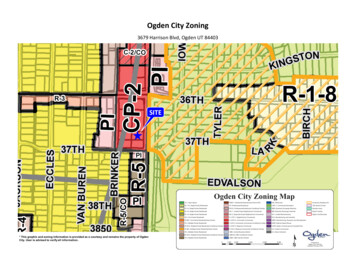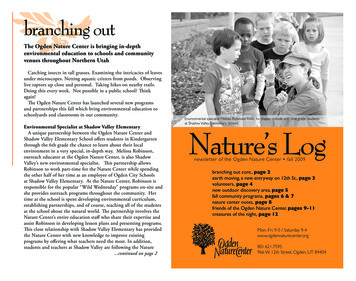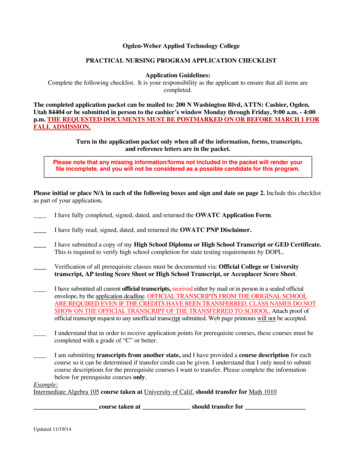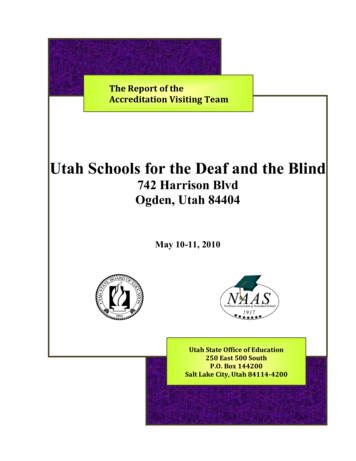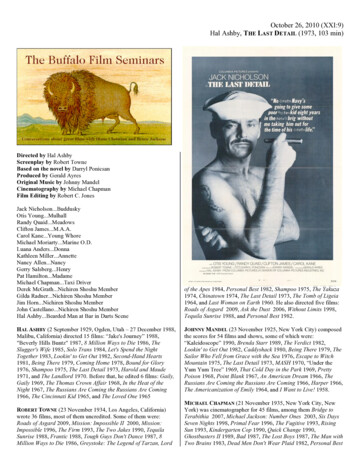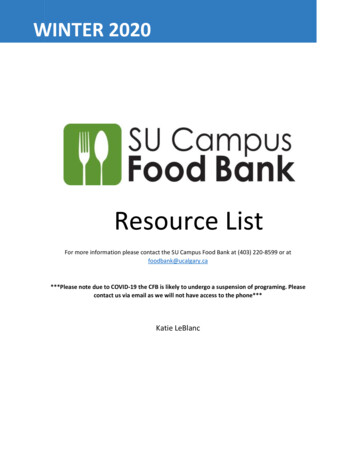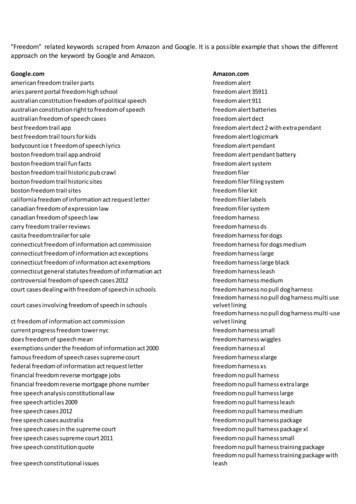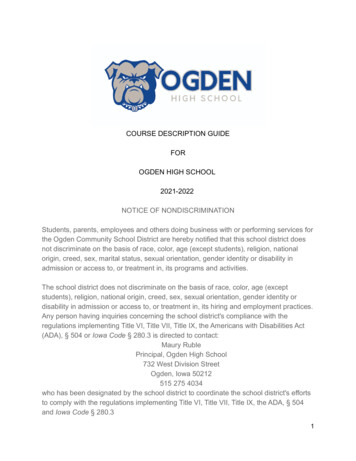
Transcription
COURSE DESCRIPTION GUIDEFOROGDEN HIGH SCHOOL2021-2022NOTICE OF NONDISCRIMINATIONStudents, parents, employees and others doing business with or performing services forthe Ogden Community School District are hereby notified that this school district doesnot discriminate on the basis of race, color, age (except students), religion, nationalorigin, creed, sex, marital status, sexual orientation, gender identity or disability inadmission or access to, or treatment in, its programs and activities.The school district does not discriminate on the basis of race, color, age (exceptstudents), religion, national origin, creed, sex, sexual orientation, gender identity ordisability in admission or access to, or treatment in, its hiring and employment practices.Any person having inquiries concerning the school district's compliance with theregulations implementing Title VI, Title VII, Title IX, the Americans with Disabilities Act(ADA), § 504 or Iowa Code § 280.3 is directed to contact:Maury RublePrincipal, Ogden High School732 West Division StreetOgden, Iowa 50212515 275 4034who has been designated by the school district to coordinate the school district's effortsto comply with the regulations implementing Title VI, Title VII, Title IX, the ADA, § 504and Iowa Code § 280.31
Dear Students and Parent(s)/Guardian(s):The 2020-2021 Ogden High School Course Description Guide is designed to assist youas you make course selections that will affect your future.There are two major steps involved in planning your high school educational program:1. Student registration2. Course schedulingIt is very important that good course selections be made during registration as thenumber of seats in any given course are determined by the original count. Thus, afterthe initial registration process, some classes may be filled, while others, due to lack ofregistrants, might not be offered. Once we determine our course offerings and staffneeds, we are committed; schedule changes will be very difficult, if not impossible toaccommodate.Please consider interests, aptitudes, and educational goals before selecting the course.Students are encouraged to contact the counselor with any questions or concerns. Theselection of courses is a very important part of any student’s education. The decisionsmade today can have a definite impact upon educational and career plans. Students must enroll in a minimum of six (6) classes plus PE 48 credits are required for graduation (4 years English, 3 years of math, 3 years ofscience, and 3 years of social studies); Some courses have prerequisites which must be completed prior to enrolling Families and students are responsible to understand the entrance requirements forany post-secondary programs. The counselor is a great resource to gain moreinformation on the requirements of post-secondary programs.If you have questions about registration procedures or your specific educational plan,please contact the counselor.Good luck with the registration process and best wishes for a great school year!Sincerely,Maury Ruble, PrincipalSamantha Sperling, Counselor2
Table of ContentsSubjectGraduation RequirementsCardiopulmonary Resuscitation RequirementsRegistration ProceduresSchedule ChangesSenior Year PlusPost Secondary Enrollment Options7DMACC Course OfferingsOnline CoursesRegent Admission Index (RAI)Athletic EligibilityFour Year CompletionIndependent Study Courses12Edgenuity CoursesIowa Learning Online (ILO)12Silver CordPages444567-889-1010-12121213Department Course Offerings and DescriptionsPagesAgriculture CoursesArt CoursesBusiness Education Courses19-21Hospitality & Tourism CoursesHealth & Fitness CoursesIndustrial Technology CoursesLanguage Arts CoursesMathematics Courses31-33Music CoursesScience Education Courses36-37Social Studies Courses14-1617-1821-2222-2323-2627-3033-3537-393
Spanish Language Courses39-40AppendixRAI WorksheetCourse Add/Drop FormAppendix AAppendix B4142REQUIREMENTS, GUIDELINES, AND TIPSGraduation Requirement Ogden Community School District requires 48 credits for high school graduation,as adopted by the Ogden school board. One (1) credit is awarded for eachpassing grade in a class that meets every day of the week for a period of onesemester (18-weeks). Language Arts (8 Credits), Math (6 Credits), Science (6 Credits) must includeBiology, Physical Science, and Earth & Space Science, Social Studies (6Credits), must include American History and American Government, PhysicalEducation (4 Credits), Workplace Readiness (2 Credits), and Electives (16Credits) Total Credits 48Cardiopulmonary Resuscitation Course Completion Requirement Iowa Code256.7 (5), 12.5 (20)Subject to the provisions of sub rule 12.5(6)a, at any time prior to the end of twelfthgrade every pupil physically able to do so shall have completed a psychomotor coursethat leads to certification in cardiopulmonary resuscitation. A school or school districtadministrator may waive this requirement for any pupil who is not physically able tocomplete the course. A course that leads to certification in CPR may be taught duringthe school day by either a school or school district employee or by a volunteer, as longas the person is certified to teach a course that leads to certification in CPR. In addition,a school or school district shall accept certification from any nationally recognizedcourse in cardiopulmonary resuscitation as evidence that this requirement has been metby a pupil. A school or school district shall not accept auditing of a CPR course, nor acourse in infant CPR only.4
Registration Procedures1. Please take time to read this course description guide carefully. Course offeringsmay change from year-to-year so you will want to make sure you are updated onspecific details in each.2. A great deal of planning is done based upon your choices. We ask that youregister carefully for classes.3. Schedule changes will only be allowed with administrative approval. Please see“Schedule Changes” for dropping or adding a course.4. Questions related to scheduling should be directed to the school counselor.Note to Students/ParentsDue to various internal and external factors that may occur after printing this registrationguide, please consider the process of student registration a fluid one. Changes inpersonnel, federal and state requirements, and budgetary constraints are all factors thatforce the guidance department and/or principal’s office to make changes during theprocess. This may include altering, adding, or dropping course offerings that are listedin this registration guide. We appreciate your patience and understanding.To accommodate all persons, the high school office will release addendums, whenappropriate, to supplement this guide to registration. Those addendums will beannounced to students and published on the high school’s website.Schedule ChangesWhen requesting a schedule change, please keep in mind that the master schedule isdeveloped by the number of course selections identified by students during theregistration process. School administrators make decisions regarding the number ofsections per department based on students’ course selections. For those reasons, weask that students please be wise when initially registering and inputting their courserequests. The following outlines our policy on schedule changes.After the initial registration and scheduling that takes place, student schedule changesmay only be made according to ONE the following criteria:1. Approved level changes by the parent, teacher or counselor.2. Failure in first or second semester course(s).3. Computer and/or clerical error. Students may look at their original requests withthe counselor.4. Special education placement.5. Failure to meet a course prerequisite.6. Seniors who must enroll in a course to meet graduation requirements.7. Wanting to add a course without disturbing the rest of the master schedule.5
All schedule changes must be made prior to the beginning of the term with the student’scounselor. Approval by parent, teacher or counselor is necessary for anyaddition/deletion of a course.SENIOR YEAR PLUSEnacted by the Iowa Legislature, Senior Year Plus was created to provide increasedand more equal access to college credit nd-community-college/senior-year-plus-syp). Courses delivered through Senior Year Plus provide students the opportunity to take arigorous college curriculum and receive, in many cases, both high school and collegecredit concurrently. At Ogden High School joint-enrolled courses may include: Concurrent Enrollment Courses (those receiving college & high school credit). Online Career Academy Hunziker Career Academy courses (at DMACC) On-site college-level courses, including Advanced Placement (AP) courses.The state guidelines require all students enrolling in Senior Year Plus eligible courses tobe proficient in reading, math, and science as assessed through the Iowa Assessmentbattery of tests. In addition, if a student wishes to drop the DMACC credit portion of theaforementioned classes, the student must also drop the OHS credit. If this date isbeyond the OHS official drop date each semester, the student will receive an ‘F’ for theOHS credit portion. (may need to add another class to remain at full-time status).State Approved Criteria Ensuring Reading, Math and Science Proficiency asrequired by Senior Year Plus (SYP)1. The student is proficient on the reading, math, and science portions of the ISASP.Proficiency for Reading/Math/Science is a score of 259. If a student at OgdenHigh School is not proficient, they must fulfill the Senior Year Plus requirement.This can be accomplished by fulfilling one of the following two alternativeproficiency requirements. NOTE: Students would only need to meet alternativeproficiency requirements in the areas (reading, math, science) not met via theISASP Iowa State Assessment of Student Progress testing: Sophomores- ELA530, Math 537, Science 545 and Juniors- ELA 561, Math 559, Science 545.2. The student is proficient on the reading, math, and/or science portions of theAmerican College Testing exam (ACT). Proficiency is a score of 18 or higher oneach individual portion.3. The student is proficient on the reading, math, and/or science portions of theirmost recent ACCUPLACER test. Proficiency will be determined by the following6
scores: READING & SCIENCE: 35 on the Reading Skills portion of theACCUPLACER test. MATH: 24 on the Math Skills portion of the ALEKS test.DMACC Concurrent Credit Courses at Ogden High SchoolThe courses listed below are offered to juniors and/or seniors at Ogden High School forboth Ogden High School and Des Moines Area Community College (DMACC) credit.Junior and senior students taking these classes must register for DMACC credit. This isat no expense to the student. Students taking DMACC credit will be generating acollege transcript while attending high school. All students taking a college class atOgden High School will take the final exam.Ogden High School Course TitleDMACC Course NumberDMACC CreditsDMACC Calculus IMAT 2115 CreditsDMACC Communication SkillsCOM 7033 CreditsDMACC StatisticsMAT 1574 CreditsDMACC Applied MathMAT 7723 CreditsDMACC Career Academy Courses at Hunziker Center-AmesThe programs listed below are available to Ogden High School juniors and seniors whoqualify. Courses in each area are offered on site at the Hunziker Career Center in admaccclasses.aspxCareer Advantage Programs Offered at Hunziker-AmesAuto CollisionTechnologyAuto TechnologyBuilding Trades/FinishCarpenterCriminal JusticeCulinary ArtsHealth Occupations*SCALE ProgramTeacher AcademyWelding (Nevada HS)SCALE draws upon the expertise of business partners to bring real world applications7
into the comprehensive high school experience. Through a collaboration of education,business, and industry, the SCALE program seeks to develop highly skilled andadaptable innovators and leaders. With inquiry-based learning and authentic projectsand experiences, students add value to business partners while exploring passions andcareer possibilities identified by economic trends in Story County. Students will do acombination of classroom work and work-based internship-type experience.- Multi-Disciplinary Engineering- Health and Human Services- Business Communication and Technology- Renewable Energy and Bio-SciencesDMACC Career Academy Courses at Van Kirk Center- PerryThe programs listed below are available to Ogden High School juniors and seniors whoqualify. Courses in each area are offered on site at the Van Kirk Career Center in Perry.Career Advantage Programs Offered at Van Kirk Center- PerryAcademic CoursesAgribusinessAutomotive TechnologyBusinessCriminal JusticeEmergency Medical Technician(EMT)Health OccupationsTeacher AcademyWeldingOnline CoursesOnline, college-level courses may be completed by students who wish to expand theirknowledge-base and/or explore curricular areas not offered at Ogden High School.Students can take online Advanced Placement (AP) courses offered by the Belin-BlankCenter at the University of Iowa or select online courses offered through Des MoinesArea Community College cademy.aspx8
9
Entrance to Iowa Regents InstitutionsA Regent Admission Index (RAI) score will be calculated for freshman applicants to anyof the three Regent universities. Admission will be based on the RAI which combinesfour factors: 1.) ACT composite score; 2.) high school rank; 3.) high school grade pointaverage; and 4.) the number of high school courses completed in the core subjectareas.Students who have an RAI of 245 or greater and have successfully completed therequired core subject area courses will be eligible for automatic admission to any of thethree Regent universities. The freshman applicants from Iowa schools who have an RAIbelow 245 will have these applications reviewed on an individual basis and theadmission decision will be specific to each institution. A “web calculator,” which can beused as an informal way for a student to calculate his/her Regent Admission Index, isavailable at Board of Regents State of Iowa.Enter the number of full-year courses that you’ve taken or plan to take in English,mathematics, natural science, social science, and foreign language. (A one-semestercourse counts as 0.5). While additional courses in areas such as the fine arts andtechnology will help round out your high school experience and prepare you for futurecareers, they are not part of the core courses used to calculate your admission index. SAT scores will be converted to ACT composite equivalent. High school rank is expressed as a percentile with 99% as the top value. High school GPA is expressed on a 4-point scale.ATHLETIC ELIGIBILITYNCAA ClearinghouseAll students planning to enroll in college as a freshman and wanting to participate inDivision I or Division II athletics must be certified by the NCAA Eligibility Center(formerly called the NCAA Clearinghouse). The Eligibility Center was established toensure consistent application of NCAA initial-eligibility requirements for all prospectivestudent athletes at all member institutions. It is the responsibility of the prospectivestudent athlete to make sure the Eligibility Center has the documents it needs to certifyhis/her eligibility.Division I 16 Core-Course Rule16 Core Courses 4 years of English, 3 years of mathematics (Algebra I or higher), 210
years of natural/physical science (1 year of lab if offered by highschool), 1 year of additional English, mathematics ornatural/physical science, 2 years of social science, 4 years ofadditional courses (from any area above, foreign language ornon-doctrinal religion/philosophy).Division II 16 Core Course Rule16 Core CoursesIf you enroll full time in a Division II college on or after August 1, 2013, and want toparticipate in athletics or receive an athletics scholarship during your first year, youmust: Graduate from high school, 3 years of English, 2 years ofmathematics (Algebra I or higher), 2 years of natural/physicalscience (1 year of lab if offered by high school), 3 years ofadditional English, mathematics or natural/physical science, 2 yearsof social science, 4 years of additional courses (from any areaabove, foreign language or non-doctrinal religion/philosophy). Earn a 2.0 grade point average or better in your core courses. Earn a combined SAT score of 820 or an ACT sum score of 68.A student may apply to the NCAA Eligibility Center at any time during his/her highschool years. However, it is recommended the student apply prior to taking the ACT orSAT exam. This application, and additional information, may be completed online atNCAA Clearinghouse. The student must have his/her ACT or SAT scores sent to theNCAA Eligibility Center each time the test is taken. The NCAA Eligibility Centerinstitution code is 9999. All prospective student-athletes need to work with their schoolcounselors and carefully plan their schedules each year to ensure NCAA eligibility. TheNCAA eligibility rules and list of acceptable courses often change. It is the responsibilityof the student to seek out the necessary information to make course selectiondecisions.Approved OHS Courses through the NCAA eMiscellaneousEnglish IAmericanHistoryAlgebra IPhysicalScienceSpanish I11
English IISociologyGeometryBiologySpanish 2American Lit /World LitPsychologyAlgebra 2Chemistry ISpanish 3CreativeWritingCurrent AffairsPre-CalculusPhysicsSpanish 4Early WorldHistoryStatisticsEnvironmentalScienceModern WorldHistoryCalculusAnatomy &PhysiologyWorld CulturesDMACCCalculus IChemistry IIGovernmentDMACCStatisticsNational Association of Intercollegiate Athletics (NAIA)PlayNAIA: NAIA Eligibility CenterThe NAIA Eligibility Center is responsible for determining the NAIA eligibility of first-timestudent athletes. Any student playing NAIA sports for the first time must meet theeligibility requirements. Students must have their eligibility determined by the NAIAEligibility Center, and all NAIA schools are bound by the center’s decisions.FOUR YEAR COMPLETIONIt is the desire of the faculty, staff and administrative team, as well as a mandate fromthe State of Iowa, that all students complete their high school diploma within four yearsof entering high school. In order to facilitate that goal, the options listed below areavailable for students who might need to recover credits. Please note the specificrequirements in each area.Independent Study CoursesCourses at the high school are not available on an independent study basis. However, ifextenuating circumstances should exist, we may review the student’s case and considerindependent study. Permission of the high school principal is required before anyindependent study arrangements should be discussed.12
Edmentum CoursesEdmentum is a computer-based curriculum. Students who utilize this curriculum aresubject to the following course-completion requirements: Courses are available only after the locally instructed course has beenattempted. Administration has the final decision on the taking Edmentumcourses. If successfully completed, the Edmentum course will satisfy local graduationrequirements. Edmentum grades will be added to the student’s transcript, but will not replacethe original grade on the transcript. Course grades will not be included in the student’s GPA.Silver CordThe purpose of the Silver Cord Program is to encourage students to make acontribution to their community through service/volunteer hours and to recognize thoseefforts. The award can be earned by completing the required hours of approvedcommunity service with non-profit organizations. It is suggested that students completea minimum of 50 hours of approved service activities per year to reach a total of 200hours; however, students may accumulate their 200 hours in varying amounts duringtheir four years of high school. Students should receive approval for community serviceactivity prior to completing the time. Students must have at least 50 hours submitted bythe end of the sophomore year in order to be eligible for Silver Cord. Students thatmeet all program requirements will receive a silver cord to wear on their robes duringtheir commencement ceremony.Agriculture Education CoursesIntroduction to Agriculture, Food 9,10,11,12& Natural ResourcesSCED Code: 05010Prerequisite: NoneYear2 CreditsDescriptionIntroduction to Agriculture, Food, and Natural Resources (AFNR) is the introductorycourse where students will experience exciting “hands-on” activities, projects, andproblems related to agriculture. It is designed to introduce students to the many careerpathways in the agricultural industry. In addition to a brief overview of animal science,plant science, natural resources, and agricultural technology and systems, students willexplore FFA, leadership, communication and science in agriculture.13
Animal Science10,11,12SCED Code: 05000Prerequisite: NoneYear2 CreditsCourse Description: This course is designed to provide students a general overview ofthe livestock industry. It identifies the ways in which domestic animals serve the basicneeds of human foods, fiber, shelter, protection, fuel, and emotional well-being. Studentswill develop an understanding of and be able to apply the basic principles of animalselection, breeding, genetics, feeding, health and husbandry practices. As a student youwill become familiar with the economic and social issues that confront the livestockindustry.Plant Science/Horticulture10,11,12SCED Code: 05010Prerequisite: Introduction to AgricultureSemester2 CreditsConsiderations: The course is structured to enable all students to have a variety ofexperiences that will provide an overview of the field of agricultural science with afoundation in plant science so that students may continue through a sequence ofcourses through high school.Course Description: Students will explore hands-on projects and activities to learn thecharacteristics of plant science and work on major projects and problems similar tothose that plant science specialists, such as horticulturalists, agronomists, greenhouseand nursery managers and producers, and plant research specialists face in theirrespective careers. Students will investigate, experiment, and learn about documentinga project, solving problems, and communicating their solutions to their peers andmembers of the professional community.Agriculture Business 10,11,12Semester 1 CreditSCED Code: 18201 Agribusiness ManagementThis course focuses on decision making and problem solving within agriculturalbusinesses. Students will discover topics including ag marketing, financing, ag careers,communication, and international ag awareness. Students will be utilizing virtualfarming simulations, creating marketing strategies for the FFA, and creating their ownbusiness concepts throughout the semester. If time allows, students will be creatingand marketing their own products to the community.14
Veterinary Science 10,11,12Semester 1 CreditSCED Code: 18105Veterinary Science courses impart information about the causes, diagnosis, andtreatment of diseases and injuries of animals, typically emphasizing domestic andfarm animals. Course topics focus on anatomy and physiology, nutrition, behavior,and reproduction, but may also include other areas of study as appropriate.Agricultural Entrepreneurship 10,11,12Semester 1 CreditSCED Code: 18202Agricultural Entrepreneurship courses focus on the personal skills necessary forsuccess in entrepreneurial ventures in the agricultural industry. Topics include settinggoals, assessing and solving problems, evaluating financial progress and success,business planning, information management and evaluation, and recordkeeping.Agricultural Metals & Welding 10,11,12Prerequisite: Introduction to AgricultureSemester1 CreditConsiderations: This course will be a laboratory course where students will learnwelding and metal fabrication skills. Students will need to follow shop safety policiesCourse Description: Ag Metals and Welding will cover shop safety, weldingfundamentals and procedures, and metal cutting and fabrication. Students will completeweld lab activities to master basic welding processes including MIG, TIG, and stickwelding. The final component of this course has students apply their skills to plan,design, and create a metals project related to the agricultural mechanics field.Art CoursesJewelry & CraftsSCED Code: 051669,10,11,12Semester1 CreditJewelry & Crafts is for students interested in two-dimensional and three-dimensionalmedia to create functional art. The student will be introduced to jewelry & crafts relatedstudio activities, terminology and art history/culture. Media will include: metal, paper,found objects wire, fibers and glass. Composition and workmanship will be reviewed15
and integrated into each problem, as well as basic creative thinking tools. Careerrelated problems will be integrated and explored.DrawingSCED Code: 051569,10,11,12Semester1 CreditDrawing is for the student interested in working with two-dimensional drawing media.The student will be introduced to drawing studio activities, terminology and arthistory/culture. Drawing media will include; pencil, ink, colored pencil, chalk pastels, oilpastels, and charcoal. Composition and workmanship will be reviewed and integratedinto each problem, as well as basic creative thinking tools. Career related problems willbe integrated and explored.Painting and PrintmakingSCED Code: 051609,10,11,12Semester1 CreditPainting and Printmaking is for the student interested in working with 2D art media ofpainting and printmaking. The student will be introduced to painting and printmakingstudio activities, terminology and art history/culture. Media will include; acrylic,watercolor, monoprints and screenprinting. Composition and workmanship will bereviewed and integrated into each problem, as well as basic creative thinking tools.Career related problems will be integrated and explored.3D DesignSCED Code: 051599,10,11,12Semester1 Credit3-D Design is for the student interested in working with three-dimensional media tocreate pottery and sculpture. The student will be introduced to sculpture and clay studioactivities, terminology and art history/culture. Media will include: clay, found objects,plaster, and wire. Composition and workmanship will be reviewed and integrated intoeach problem, as well as basic creative thinking tools. Career related problems will beintegrated and explored.Art Advanced StudySCED Code: 0519712Year2 CreditsPrerequisite: At least three electives and teacher approval16
Advanced Art is intended for students who seriously want to pursue art as a career, as avocation, and want to put together a personal portfolio or expand their creative thinkingskills and ability. Independent projects are planned and guided by the student andteacher. Media will be determined by the student. Creative processes are explored indepth focusing on various subjects, theories, themes, techniques and styles.Business Education CoursesThe Mission of Business Education at Ogden High School is to work cooperatively withthe business community to prepare all individuals to live and work as productive citizensin a changing global society by providing essential business education, experiences,and training. These experiences should actively engage students using instructionalstrategies that rely on the use of technology and practices that reflect current andemerging business procedures.Workplace ReadinessSCED Code: 120019Year2 CreditsPrerequisite: NoneWorkplace Readiness is a career and technical education business course. Thecurriculum provides instruction based on career exploration, introductorybusiness/economic concepts, with an emphasis on the integration and application ofcurrent technology, communication, employability skills, and personal financialresponsibility.Business CommunicationsSCED Code: 1200910, 11, 12Year2 CreditsPrerequisite: Workplace ReadinessBusiness Communications courses help students to develop an understanding andappreciation for effective communication in business situations and environments.Emphasis is placed on all phases of communication: speaking, listening, thinking,responding, reading, writing, communicating nonverbally, and utilizing technology forcommunication. Business communication functions, processes, and applications in thecontext of business may be practiced through problem-based projects and real worldapplication.Introduction to Accounting11,12Semester1 Credit17
SCED Code: 12104Prerequisite: NoneAccounting I is an introductory course in accounting fundamentals and procedures. Itincludes capturing and analyzing business data and financial statement preparation.The double-entry bookkeeping system is presented with a focus on the end result of theaccounting cycle, the financial statement. There is a focus on real-world applicationsdesigned to help students see the critical role accounting plays in the business world.Accounting II11,12SemesterSCED Code: 12104Prerequisite: Introduction to AccountingAccounting is the most dynamic tool of business! Topics covered in this course includeaccounting for: bad debts, notes receivable and payable, merchandise inventory,intangible assets, partnerships, corporations, statement of cash flow and analyzingfinancial statements. There is a focus on a real-world applications designed to helpstudents see the critical role accounting plays in the business world.Hospitality and Tourism Management CoursesHospitality and Tourism Management 9,10,11,12SCED Code: 16001Year2 CreditsPrerequisite: NoneNote: Students are required to attend all field trips in order to successfully pass thiscourse and encouraged to participate in scheduled community activities.This cou
Ogden Community School District requires 48 credits for high school graduation, as adopted by the Ogden school board. One (1) credit is awarded for each passing grade in a class that meets every day of the week for a period of one semester (18-weeks). Language Arts (8 Credits), Math (6 Credits), Science (6 Credits)must include

